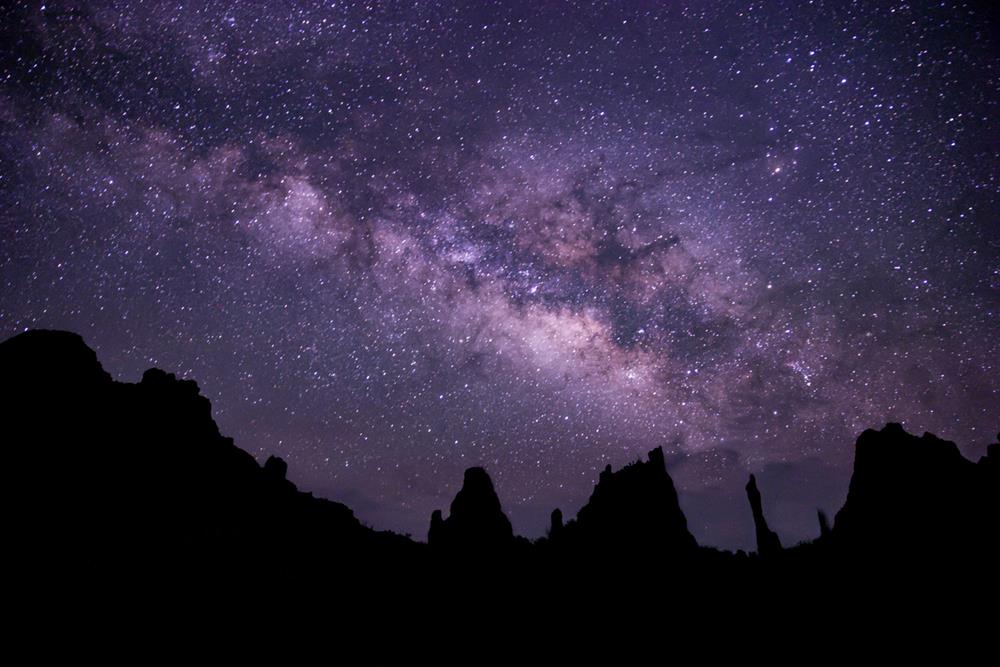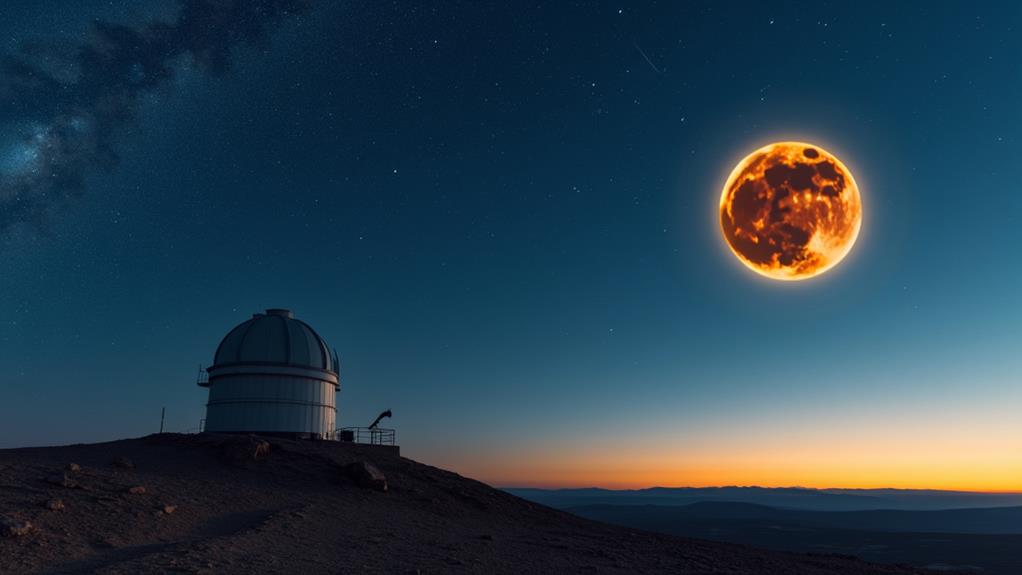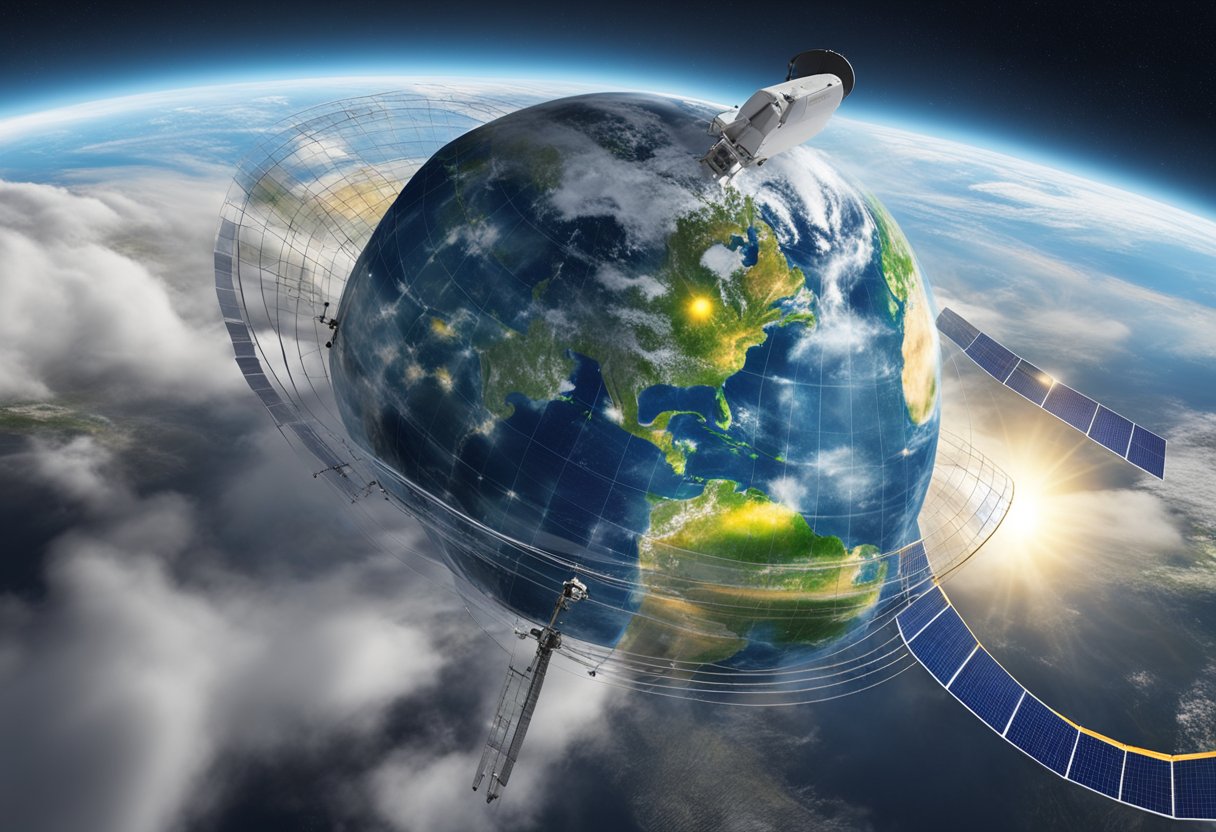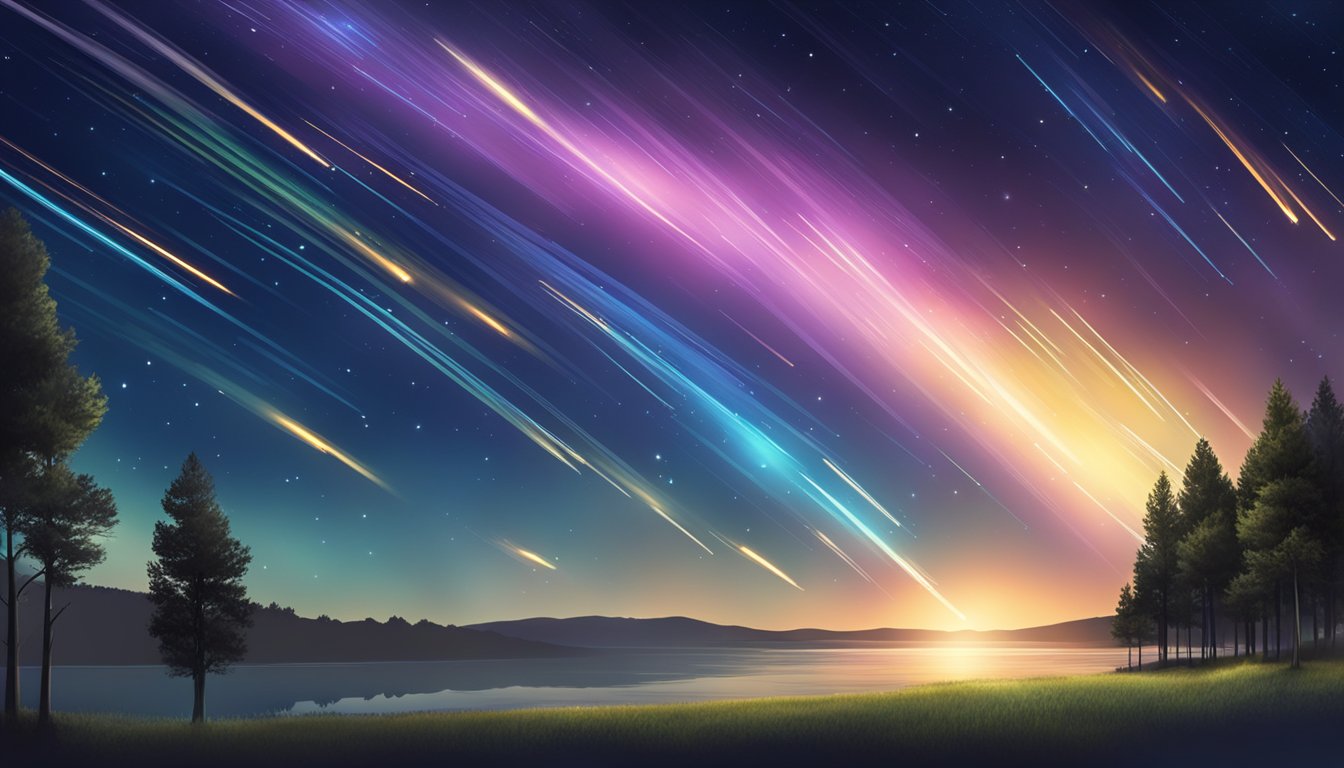Top Spots to Watch Meteor Showers
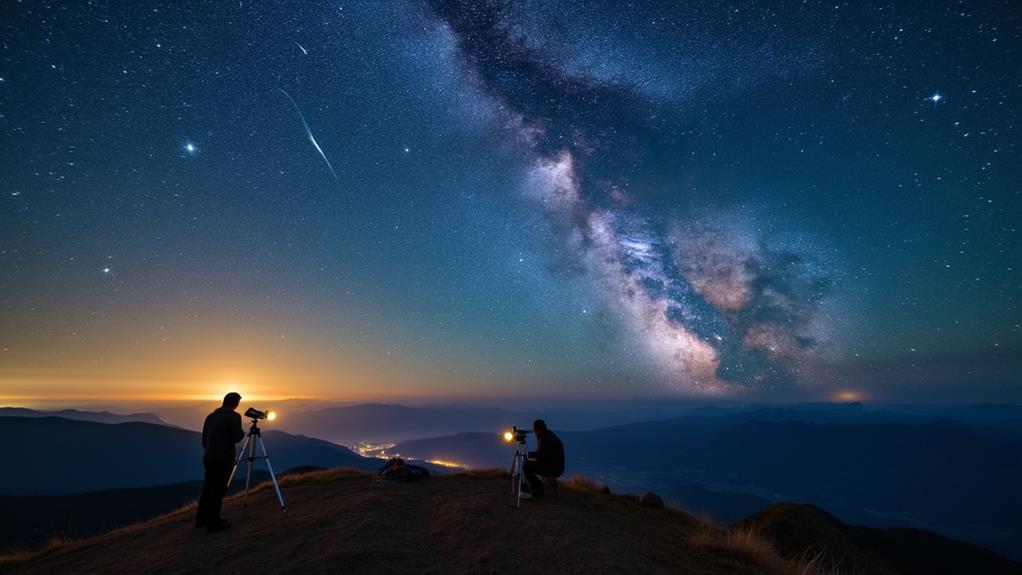
For the best meteor shower experiences, check out Dark Sky Parks like Cherry Springs State Park and Joshua Tree National Park, known for their incredible 360-degree views and astrophotography events. Head to national parks such as Grand Canyon and Acadia for breathtaking landscapes and stargazing programs. Rural areas with minimal light pollution like Big Bend National Park offer clear, dark skies making meteors easier to spot. Desert locations such as Anza-Borrego State Park provide dry, clear conditions, while coastal sites like Outer Banks deliver unobstructed views. Exploring these sites will reveal more about exceptional meteor shower watching spots.
Key Takeaways
- Cherry Springs State Park: Renowned for its 360-degree dark sky views, ideal for meteor showers.
- Joshua Tree National Park: Designated Dark Sky Park, known for annual meteor shower events.
- Big Bend National Park: Prime location for meteor shower viewing with exceptional dark skies.
- Acadia National Park: Offers dark skies and accessible viewing spots, perfect for meteor showers.
- Outer Banks, North Carolina: Remote beaches with minimal light pollution, excellent for meteor shower visibility.
Dark Sky Parks
With regard to witnessing breathtaking meteor showers, Dark Sky Parks are where you want to be. These designated areas minimize light pollution, offering the perfect conditions for stargazing and catching those elusive shooting stars. Cherry Springs State Park in Pennsylvania stands out with its renowned Astronomy Field, providing 360-degree views and hosting annual star parties that draw enthusiasts from all over.
Grand Canyon National Park, designated as a Dark Sky Park in 2019, offers numerous stargazing programs, ensuring minimal interference from artificial lights. Imagine watching a meteor shower with one of the world's most iconic landscapes as your backdrop. Joshua Tree National Park in California, recognized as a Dark Sky Park in 2017, is another prime location. It's a hotspot for astrophotography, and their meteor shower viewing events shouldn't be missed.
Big Bend National Park in Texas, designated in 2012, boasts exceptional dark skies due to its remote location. This makes it an ideal place for improved meteor visibility. So, if you're looking to experience the wonder of meteor showers, these Dark Sky Parks are your ultimate destinations for an unforgettable celestial show.
National Parks
National Parks offer some of the best opportunities for meteor shower viewing, thanks to their expansive, open spaces and commitment to preserving natural darkness. With minimal light pollution, these parks provide exceptional night sky conditions, making them perfect for catching a meteor shower.
Big Bend National Park in Texas is a prime example. Recognized as a Dark Sky Park, it offers stunning views of the night sky, making it an ideal location for meteor shower viewing. Joshua Tree National Park in California, designated a Dark Sky Park in 2017, hosts annual meteor shower events and provides excellent conditions for astrophotography.
Grand Canyon National Park, which achieved Dark Sky Park status in 2019, features numerous stargazing programs and breathtaking landscapes that improve your viewing experience. Meanwhile, Mammoth Cave National Park in Kentucky, certified as a Dark Sky Park in 2021, offers outdoor lighting retrofits and ranger-led stargazing programs to preserve and celebrate the night sky.
Acadia National Park in Maine, with its Dark Sky designation achieved in 2021, provides accessible viewing locations and organizes stargazing programs to engage you with the beauty of the night sky. These parks guarantee that your meteor shower experience is both memorable and awe-inspiring.
Rural Areas
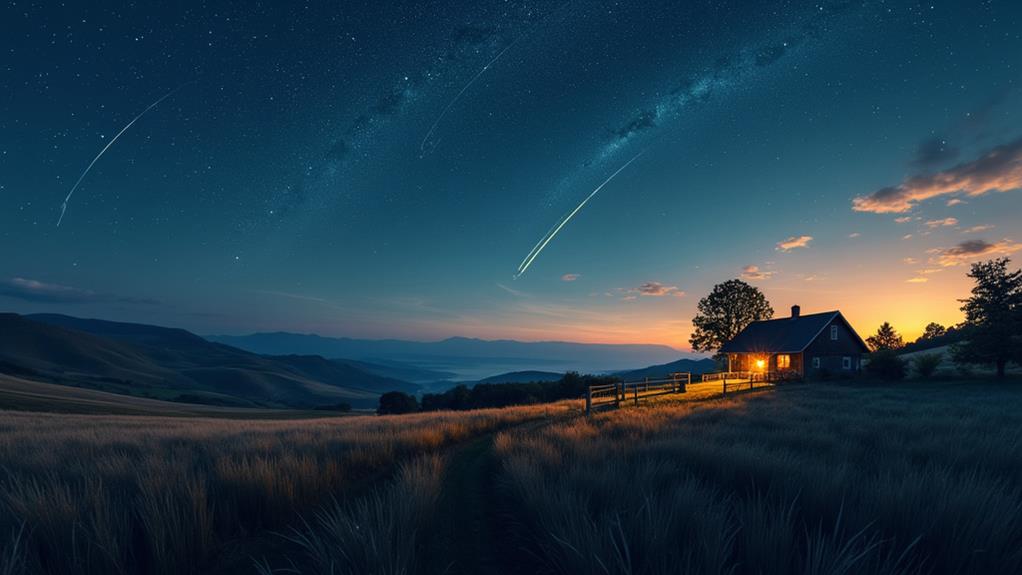
Rural areas offer some of the best conditions for meteor shower viewing, thanks to their minimal light pollution and clear, dark skies. If you're planning to catch the spectacular Perseid meteor shower, heading to a rural location can make all the difference. In these areas, you'll enjoy ideal viewing conditions and can see about 40 meteors per hour under perfect circumstances, a stark contrast to the fewer sightings in urban settings.
The absence of city lights in rural locations improves visibility, making it easier to spot fainter meteors. For the Perseid meteor shower, the best times to watch are in the pre-dawn hours when the radiant point in the constellation Perseus is high in the sky. Clear, dark skies in rural regions are crucial for maximizing your meteor shower experience, allowing meteors to be visible anywhere in the sky.
Consider visiting renowned locations like Cherry Springs State Park in Pennsylvania or Big Bend National Park in Texas. These spots are famous for their exceptionally dark skies, making them perfect for stargazing during meteor showers. So, pack your gear and head to rural areas for an unforgettable meteor shower experience.
Desert Locations
Desert locations frequently offer some of the best conditions for meteor shower viewing. With minimal light pollution and clear skies, deserts like Anza-Borrego Desert State Park in California are ideal for meteor watching. The unique landscapes of the Mojave Desert provide stunning backdrops for stargazing events, enhancing your complete experience of witnessing meteor showers.
Joshua Tree National Park, a designated Dark Sky Park, is a prime example. It hosts annual meteor shower viewing events that draw both amateur and professional astronomers. The dry air and low humidity in desert regions contribute to clearer skies, making them perfect spots for observing meteor showers like the Perseids. You'll find that the cooler nighttime temperatures in these areas also make it comfortable for extended stargazing sessions during peak meteor shower nights.
Desert locations are unparalleled for their meteor watching advantages. Regardless of whether you're at Joshua Tree or another Dark Sky Park, the combination of minimal light pollution, clear skies, and comfortable temperatures makes these spots unbeatable. So, pack your telescope and head to the desert for an unforgettable stargazing adventure. You'll be amazed at the celestial wonders that await you in these pristine, clear skies.
Coastal Sites
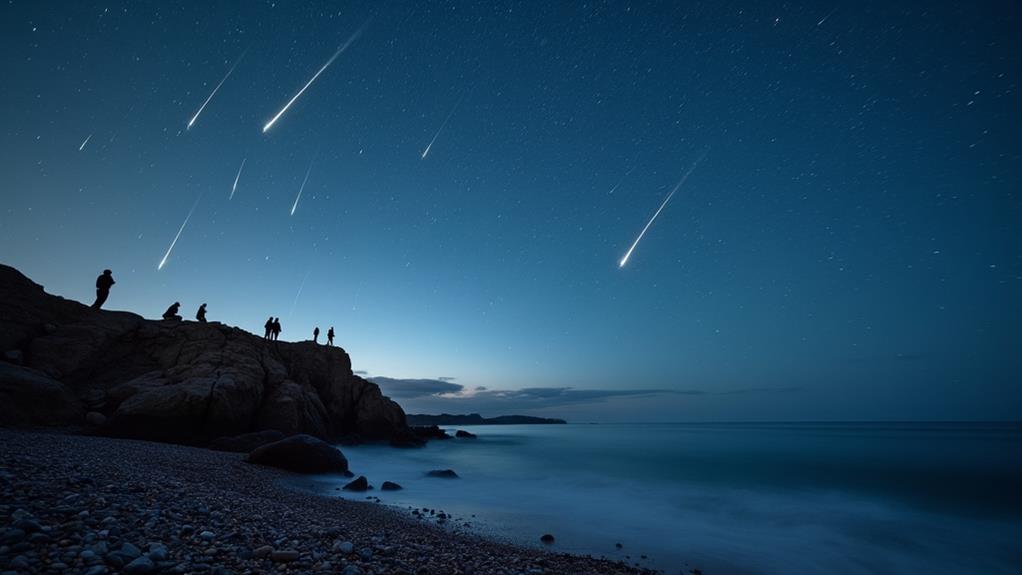
Imagine yourself standing on a pristine beach with the vast night sky stretching above you, unobstructed by trees or buildings. Coastal sites offer some of the best venues for watching meteor showers, thanks to their expansive views and dark skies. These locations often feature clear skies due to ocean breezes, reducing humidity and clouds, which creates ideal conditions for meteor watching.
Consider these top coastal sites for your next stargazing adventure:
- Acadia National Park, Maine: Located along the rugged coastline, Acadia offers dark skies and hosts stargazing programs to improve your meteor-watching experience. The park's remote location guarantees minimal light pollution.
- Outer Banks, North Carolina: Famous for its remote beaches, the Outer Banks provide an excellent setting for meteor showers. The minimal light pollution here allows for remarkable visibility, making it a favorite among astronomy enthusiasts.
- Point Reyes National Seashore, California: Known for its stunning coastal vistas, Point Reyes boasts dark skies perfect for observing meteor showers. This spot is popular among locals and visitors alike during celestial events.
Frequently Asked Questions
Where's the Best Place to See a Meteor Shower?
For the best meteor shower experience, consider that rural areas can yield up to 40 meteors per hour during peak times. Prime locations include places with minimal light pollution like Cherry Springs State Park or Big Bend National Park. Check weather conditions and local observatories for ideal viewing. Join astronomy clubs or community gatherings at camping sites, and use star maps for viewing tips. Enjoy celestial events in a perfect natural backdrop.
What Direction in the Sky Should I Look for the Meteor Shower Tonight?
For tonight's meteor shower, look toward the constellation Perseus in the pre-dawn hours. Meteor shower predictions suggest this is the peak activity time. Celestial event tips recommend finding dark sky locations for the best view. Stargazing necessities include allowing 30 minutes for your eyes to adjust. Don't rely on meteor shower myths; meteors can appear anywhere. Local astronomy clubs and weather conditions can also help with viewing techniques and equipment.
Where Should I Point My Camera for a Meteor Shower?
Imagine the perfect shot: meteors streaking across the sky. To capture this, point your camera at the radiant point of the meteor shower. Use a wide-angle lens with a low f-stop for maximum light. Set a high ISO (800-3200) and a sturdy tripod for long exposures. Take multiple shots in succession. For the best results, scout your location, check your equipment, and use editing software to improve your night photography.
What Are the Best Hours to View Meteor Shower?
The best hours to view a meteor shower are between midnight and dawn due to peak viewing conditions. Consider the moon phase; a waning crescent minimizes light pollution. Different meteor types and shower frequency appear in celestial calendars. Historical events show the Perseids peak in August, while the best seasons vary. Guarantee viewer safety and use photography tips for capturing meteors.

